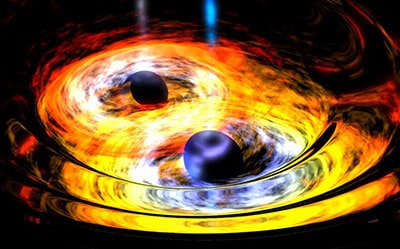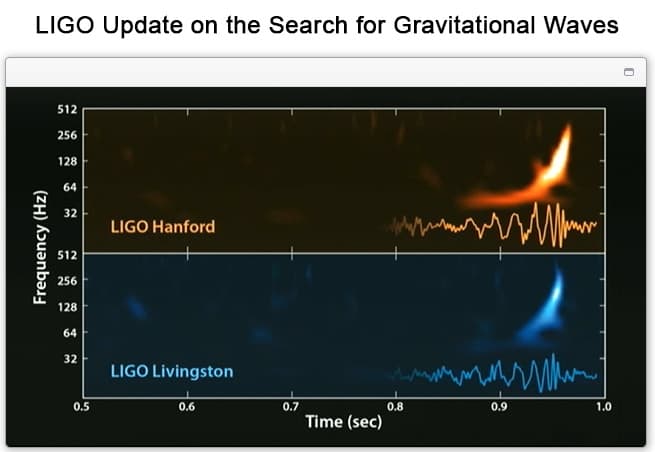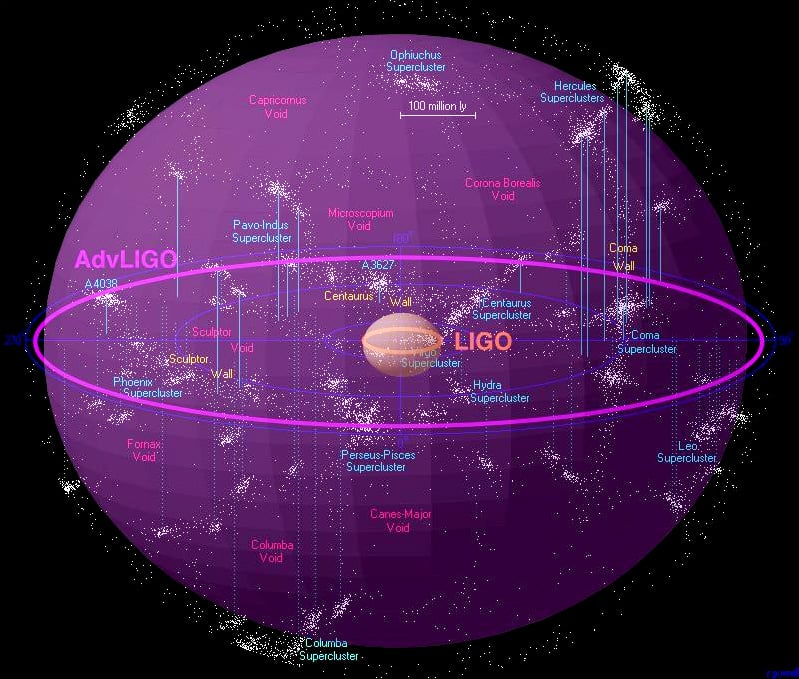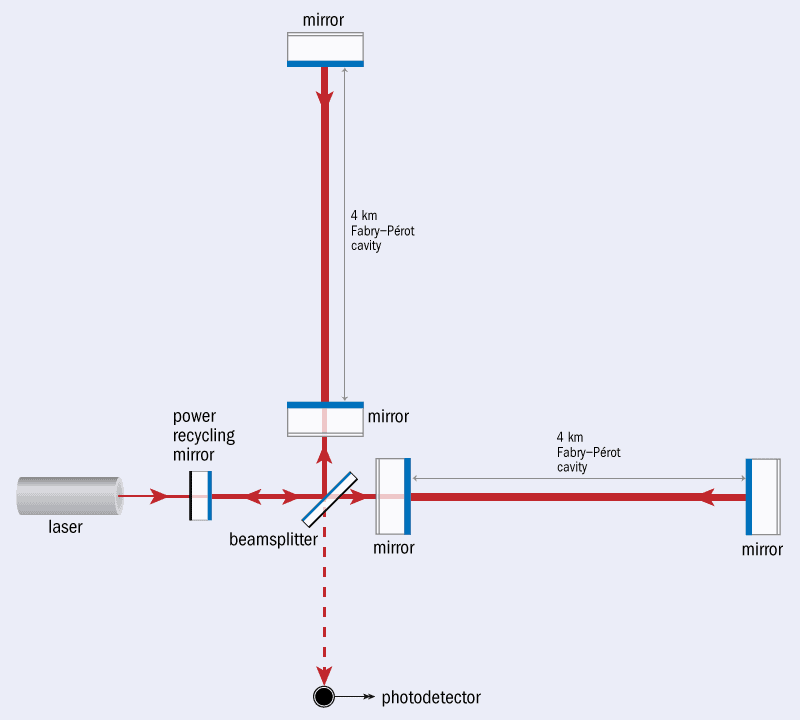
The first ever direct detection of gravitational waves has been made by researchers working on the Advanced Laser Interferometer Gravitational-wave Observatory (aLIGO) in the US. The breakthrough – announced today at a news conference in Washington, DC – ends a decades-long hunt for these ripples in space–time. This monumental observation marks the beginning of the era of gravitational-wave astronomy and provides evidence for one of the last unverified predictions of Einstein’s general theory of relativity.
The waves were produced from the collision of two black holes of 36 and 29 solar masses, respectively, which merged to form a spinning, 62-solar-mass black hole, some 1.3 billion light-years (410 mpc) away in an event dubbed GW150914. The detection was made on 14 September last year and was measured while the newly upgraded aLIGO detectors – one in Hanford, Washington, and the other in Livingston, Louisiana – were being calibrated before the first observational run began four days later.
The gravitational-wave signal lasted in both of LIGO’s interferometers for 0.2 seconds and has been measured to a statistical certainty above 5.1σ. In fact, the signal from the event was so strong that it could be visually “seen” in the data by eye. It was measured in both of LIGO’s interferometers, arriving within seven milliseconds of each other. The observation is also the first time a stellar-mass binary black-hole system has been detected. The data also showed that gravitational waves travel at light speed and that gravity has no mass, as predicted by general relativity.
“The effect we are trying to measure is so tiny that it takes something like LIGO to measure it,” says David Reitze, LIGO laboratory executive director. “It’s mindboggling.” He goes on to say, “We have been deaf, but now we can hear them. We now expect to hear things we never expected as we open a new window of astronomy. This was a scientific Moon shot, and we did it, we landed on the Moon.”
Ripples in the cosmos
Just as accelerating a charged particle produces electromagnetic radiation, so accelerating mass produces gravitational radiation – this energy is lost from the system in the form of “gravitational waves”. But unlike electromagnetic waves that travel through space–time, gravitational waves actually ripple the fabric of space–time. Such waves travel away from their source in all directions at the speed of light, compressing and expanding intervening space–time as they flow.
Any accelerating mass will produce gravitational waves so long as it is not spherically or cylindrically symmetric, which means that a perfectly spherical spinning star will not create the ripples. Since Einstein published his general theory of relativity 100 years ago, scientists have predicted that binary-star or black-hole systems would be prolific sources of gravitational waves in our universe, but such waves had never been directly detected, until aLIGO’s measurement last September.

If two black holes are stably orbiting each other, they produce a continuous stream of gravitational waves at twice the orbital frequency, carrying away the system’s rotational energy and angular momentum. Such ripples are thought to have wavelengths that are tens of light-years and are relatively weak. But if the initial separation between the two black holes is not too large then – at some point – the orbit will get smaller as the system loses rotational energy and the two holes will eventually “inspiral”.
Chirp and ring
The closer a binary pair is initially, the more radiation is emitted as the two black holes plunge into one another, which accelerates the inspiral. This process produces a characteristic “chirp” waveform in which both the amplitude and frequency of the gravitational waves increases – sometimes for less than a second – until it peaks at the merger. Given off during the last few seconds of the merger, these gravitational waves are characteristic of the mass and spin of the final black hole.
The single black hole created by such a cataclysmic merger is initially highly distorted. However, the nascent hole loses its deformity almost instantly by ringing like a bell and producing further gravitational radiation. The system quickly loses energy and the strength of the waves decays exponentially to form a “ringdown” signal. For event GW150914, aLIGO detected the chirp and the ringdown note at the end.
As the final black hole was 62 solar masses, this means that 3 solar masses’ worth of gravitational radiation was emitted during the event. The signal also revealed that the new-born black hole is a rotating Kerr black hole (with a spin parameter of 0.67). Cosmologists have modelled such a gravitational-wave signal as audible sounds, based on the frequencies of the waves as they would arrive at LIGO’s detectors. (You can listen to a chirp and ringdown here.)

The length of time that a signal remains in LIGO’s interferometers – and hence the quality of a potential detection of gravitational waves – depends inversely on the frequency that LIGO is set up to measure and the masses of the binary objects involved. It is therefore easier to detect gravitational waves at lower frequencies and from lighter objects. Before its upgrade, LIGO was able to detect gravitational waves from 40 to 10,000 Hz, but since aLIGO came online, the interferometers have been able to detect waves down to a frequency of just 10 Hz, thereby greatly extending LIGO’s reach.
B S Sathyaprakash – a physicist at Cardiff University in the UK and a member of the LIGO collaboration – says the facility is currently functioning at 30 Hz, which was still sufficient to pick up the signal at 410 mpc. Although he admits that a heavier object will last for a shorter time, the signal itself is really strong. “Big objects have a larger amplitude, so a [gravitational wave] signal from a binary black-hole system can be detected from a much greater distance than a similar signal from a neutron-star system,” he explains.
Long arm of LIGO
LIGO’s successful detection of gravitational waves is thanks to its simple but ingenious design. The two observatories are essentially Fabry–Pérot interferometers consisting of two 4 km-long arms at right angles to each other, with “test masses” in the form of pure silicon primary mirrors – each weighing 40 kg and suspended as a pendulum – at both ends of the arms. Both interferometer arms are housed in an ultrahigh vacuum.
During a run, laser light with a wavelength of 1064 nm and a power of 200 W is sent to a beamsplitter, which transmits one half of the light into one of the arms and reflects the rest down the other arm. As each arm itself is a Fabry–Pérot cavity, the light is allowed to bounce back and forth some 400 times in each arm before returning to the beamsplitter. This effectively increases the arm length to nearly 1600 km, boosting aLIGO’s sensitivity.
After the bounces, light from each arm returns to the beamsplitter, where the two beams combine. Some of this light is again transmitted through the beamsplitter and is detected at the photodetector (see diagram below).

Riding the wave
If the light travels exactly the same distance down both arms, the two combining light waves interfere destructively, cancelling each other so that no light is observed at the photodetector. But if a gravitational wave slightly stretches one arm and compresses the other, the two beams would no longer completely subtract each other, producing an interference pattern at the detector. This pattern contains information about how much the two arms have lengthened or shortened, which in turn tells us about what produced the gravitational waves.
The aLIGO facility does not, however, measure the change in path-length because the gravitational wave compresses or expands the light’s wavelength too. Instead, what the device reveals are tiny shifts in the period of the two light beams. If the crests or troughs of the wave arrive out of synch, they produce an interference pattern, meaning that the light acts as a clock and not a ruler.
Apart from using a Fabry–Pérot cavity to increase their sensitivity, the interferometers also have a “power-recycling mirror” placed just behind the beamsplitter. This mirror, which is partly reflective, slowly boosts the laser power from 200 W to 750 kW by reflecting nearly all of the laser light back to the beamsplitter and into the arms. Despite all of these upgrades and modifications, even a strong gravitational wave from colliding black holes displaces the mirrors by barely 10–19 m, making LIGO’s successful detection even more triumphant.
Testing Einstein
With the gravitational-wave data from the GW150914 event, the LIGO researchers were also able to check a key prediction made by general relativity, which is that gravitational waves travel at the speed of light and that the currently unknown carriers of the force – often dubbed “gravitions” – are massless. If gravitons did have mass, some physicists have reasoned, it could explain the accelerating expansion of the universe without resorting to the concept of “dark energy”. However, the aLIGO data show no evidence that the gravitational waves were anomalously dispersed, as they would if gravity had some small mass.
Chirps from the LIGO team
LIGO spokesperson Gabriela González from Louisiana State University says, “It’s been a very long road, but this is just the beginning and more is to come. We can now begin listening to the universe.” She continues, “It’s a gift of nature.”
“LIGO has opened a new window on the universe – a gravitational-wave window,” says LIGO co-founder Kip Thorne from the California Institute of Technology. “Each time a new window has opened up there have been big surprises – LIGO is just the beginning.” He continues, “Until now, we as scientists have only seen warped space–time, when it’s very calm. It’s as though we’d only seen the surface of the ocean on a very calm day when it’s quite glassy. We had never seen the ocean in a storm, with crashing waves. All of that changed on 14 September 2015. The colliding black holes that produced these gravitational waves created a violent storm in the fabric of space and time. A storm in which time speeded up and slowed down, speeded up again.”
“My reaction was ‘wow’, I couldn’t believe it,” says Reitze. “We should be seeing more in the coming year,” says Thorne. “We are going to have a huge richness in gravitational-wave signals.”
- The research is published in Physical Review Letters and is freely accessible: “Observation of gravitational waves from a binary black-hole merger”
- A supplementary paper is published in Astrophysical Journal Letters, and is also free to access: “Astrophysical implications of the binary black-hole merger GW150914”
- Last year, MIT physicist Nergis Mavalvala explained how to detect gravitational waves as part of our 100 Second Science series. See her video below.



